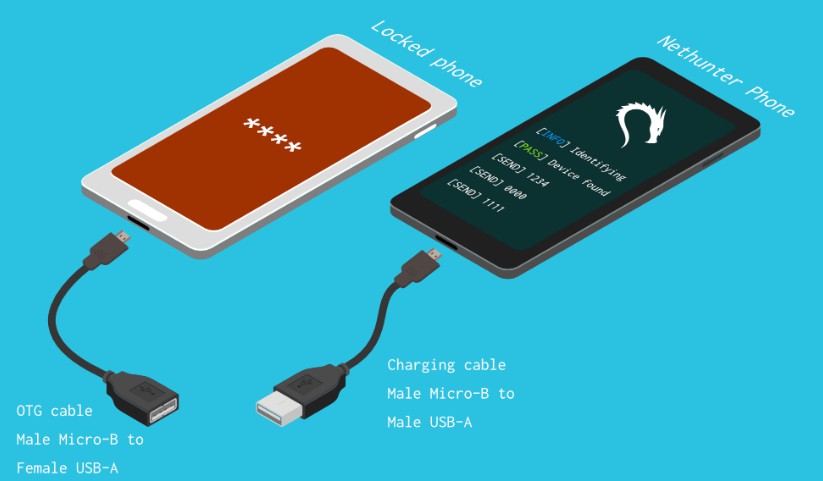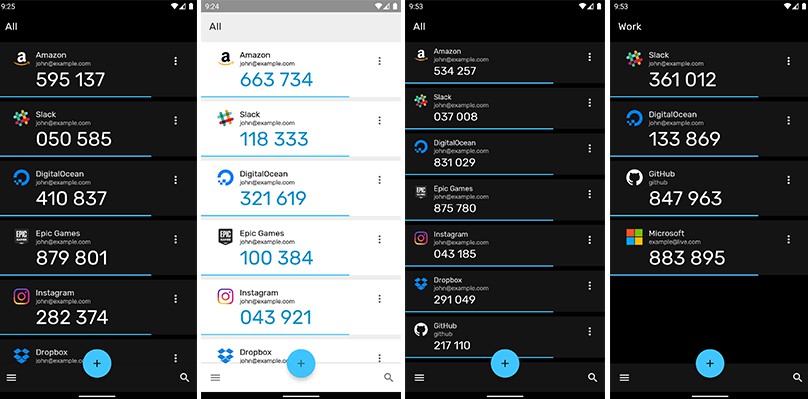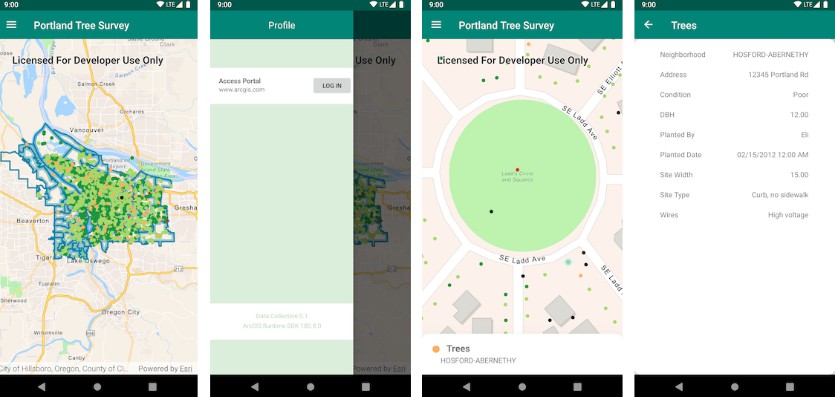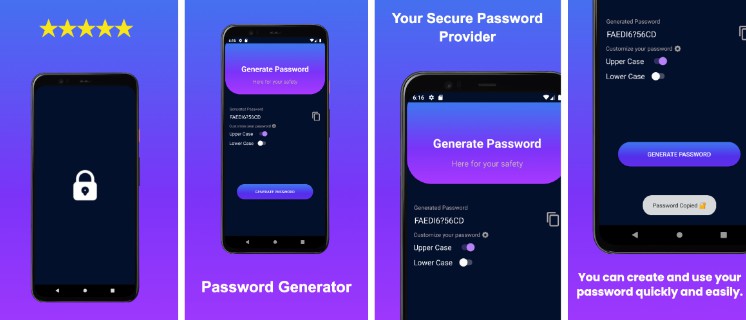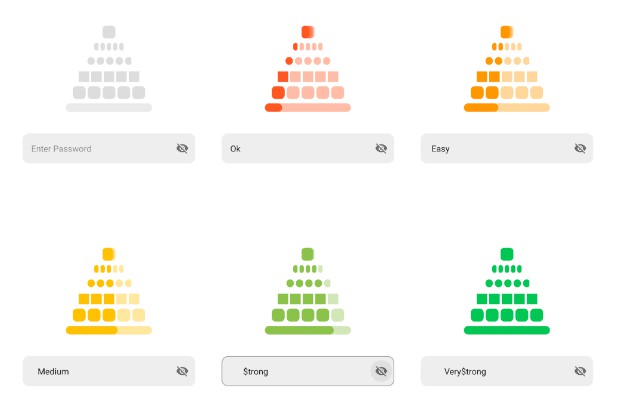Android-PIN-Bruteforce
Unlock an Android phone (or device) by bruteforcing the lockscreen PIN.
Turn your Kali Nethunter phone into a bruteforce PIN cracker for Android devices!
? How it works
It uses a USB OTG cable to connect the locked phone to the Nethunter device. It emulates a keyboard, automatically tries PINs, and waits after trying too many wrong guesses.
[Nethunter phone] <--> [USB cable] <--> [USB OTG adaptor] <--> [Locked Android phone]
The USB HID Gadget driver provides emulation of USB Human Interface Devices (HID). This enables an Android Nethunter device to emulate keyboard input to the locked phone. It's just like plugging a keyboard into the locked phone and pressing keys.
⏱ This takes a bit over 16.6 hours to try all possible 4 digit PINs, but with the optimised PIN list it should take you much less time.
? ⛓ ? You will need
- A locked Android phone
- A Nethunter phone (or any rooted Android with HID kernel support)
- USB OTG (On The Go) cable/adapter (USB male Micro-B to female USB A), and a standard charging cable (USB male Micro-B to male A).
- That's all!
? Benefits
- Turn your NetHunter phone into an Android PIN cracking machine
- Unlike other methods, you do not need ADB or USB debugging enabled on the locked phone
- The locked Android phone does not need to be rooted
- You don't need to buy special hardware, e.g. Rubber Ducky, Teensy, Cellebrite, XPIN Clip, etc.
- You can easily modify the backoff time to crack other types of devices
- It works!
⭐ Features
- Optimised PIN list
- Bypasses phone pop-ups including the Low Power warning
- Detects when the phone is unplugged or powered off, and waits while retrying every 5 seconds
- Configurable delays of N seconds after every X PIN attempts
- Log file
Installation
TBC
Executing the script
If you installed the script to /sdcard/, you can execute it with the following command.
bash ./android-pin-bruteforce
Note that Android mounts /sdcard with the noexec flag. You can verify this with mount.
Usage
Android-PIN-Bruteforce (0.1) is used to unlock an Android phone (or device) by bruteforcing the lockscreen PIN.
Find more information at: https://github.com/urbanadventurer/Android-PIN-Bruteforce
Commands:
crack Begin cracking PINs
resume Resume from a chosen PIN
rewind Crack PINs in reverse from a chosen PIN
diag Display diagnostic information
version Display version information and exit
Options:
-f, --from PIN Resume from this PIN
-m, --mask REGEX Use a mask for known digits in the PIN
-t, --type TYPE Select PIN or PATTERN cracking
-l, --length NUM Crack PINs of NUM length
-d, --dry-run Dry run for testing. Doesn't send any keys.
Usage:
android-pin-bruteforce <command> [options]
Supported Android Phones/Devices
It has been tested with these devices:
- Samsung S5 with Android 6.0.1
? PIN Lists
Optimised PIN list
pinlist.txt is an optimised list of all possible 4 digit PINs, sorted by order of likelihood.
pinlist.txt is from https://github.com/mandatoryprogrammer/droidbrute
This list is used with permission from Justin Engler & Paul Vines from Senior Security Engineer, iSEC Partners,
and was used in their Defcon talk, Electromechanical PIN Cracking with Robotic Reconfigurable Button Basher (and C3BO)
Cracking with Masks
Masks use regular expressions with the standard grep extended format.
./android-pin-bruteforce crack --mask "...[45]" --dry-run
- To try all years from 1900 to 1999, use a mask of
19.. - To try PINs that have a 1 in the first digit, and a 1 in the last digit, use a mask of
1..1 - To try PINs that end in 4 or 5, use
...[45]
Different Lock Screens
Device manufacturers create their own lock screens that are different to the default or stock Android.
You can customise the timing and prompt keys to bring up the unlock scren by setting variables in the config file.
Default configuration for Android 6.0
This is the default configuration. It sends 5 PINs before waiting for a cooldown timeout of 30 seconds.
Before each PIN is sent it sends a prompt of the ESCAPE and ENTER keys to bring up the unlock screen.
DELAY_BETWEEN_KEYS=0.1
COOLDOWN_TIME=30
COOLDOWN_AFTER_N_ATTEMPTS=5
CHANGE_AFTER_10_ATTEMPTS=0
PROMPT_BEFORE_EACH_PIN="escape enter"
Configuration for Android 10
This configuration sends a lockscreen prompt of escape and space before each PIN is sent.
It has a 30 second cooldown after each attempt.
After 10 attempts, the cooldown will occur after each PIN attempt.
DELAY_BETWEEN_KEYS=0.1
COOLDOWN_TIME=30
COOLDOWN_AFTER_N_ATTEMPTS=5
CHANGE_AFTER_10_ATTEMPTS=1
PROMPT_BEFORE_EACH_PIN="escape space"
? Roadmap
- [DONE] Works
- [DONE] Detects USB HID failures
- [DONE] Improve Usage and commandline options/config files
- [DONE] Add bruteforce for n digit PINs
- [DONE] Mask for known digits
- [DONE] Crack PIN list in reverse (to find which recent PIN unlocked the device)
- [DONE] Implement configurable lockscreen prompt
- [DONE] Implement cooldown change after 10 attempts
- Add progress bar
- Add ETA
- ASCII art
- Nicer GUI for NetHunter
- Find/test more devices to bruteforce (iPhone)
- Try to detect when phone is unlocked (Use Nethunter camera as a sensor?)
- Crack Android Patterns (try common patterns first)
? Troubleshooting
If it is not bruteforcing PINs
Check the orientation of the cables
The Nethunter phone should have a regular USB cable attached, while the locked phone should have an OTG adaptor attached.
The OTG cable should be connected to the locked Android phone. The regular USB cable should be connected to the Nethunter phone.
Refer to the graphic on how to connect the phones.
Check it is emulating a keyboard
You can verify that the NetHunter phone is succesfully emulating a keyboard by connecting it to a computer using a regular charging/data USB cable. Open a text editor like Notepad while it is cracking and you should see it entering PIN numbers into the text editor.
Note that you will not need an OTG cable for this.
Try restarting the phones
Try powering off the phones and even taking out the batteries if that is possible.
Try new cables
Try using new cables/adaptors as you may have a faulty cable/adaptor.
If it doesn't unlock the phone with a correct PIN
You might be sending keys too fast for the phone to process. Increase the DELAY_BETWEEN_KEYS variable in the config file.
? If you don't see 4 dots come up on the phone's screen then maybe it is not receiving 4 keys.
? If your phone runs out of power too soon
Try using a USB OTG cable that has an external power supply. This will charge the phone's battery while it operates.
Check the Diagnostics Report
Use the command diag display diagnostic information.
bash ./android-pin-bruteforce diag
If you receive this message when the USB cable is plugged in then try taking the battery out of the locked Android phone and power cycling it.
[FAIL] HID USB device not ready. Return code from /system/xbin/hid-keyboard was 5.
Use verbose output
Use the --verbose option to check the configuration is as expected. This is especially useful when you are modifying the configuration.
Other
Try this command in a shell on the NetHunter phone:
/system/bin/setprop sys.usb.config hid
? Known Issues
- This cannot detect when the correct PIN is guessed and the phone unlocks.
- Your phones may run out of ? battery before the correct PIN is found.
? Technical Details
This works from an Android phone because the USB ports are not bidirectional, unlike the ports on a laptop.
Keys are sent using /system/xbin/hid-keyboard. To test this and send the key 1 you can use echo 1 | /system/xbin/hid-keyboard dev/hidg0 keyboard
Before each PIN, we send the escape and enter keys. This is to keep the Android responsive and dismiss any popups about the number of incorrect PIN attempts or a low battery warning.
In Kali Nethunter, /system/xbin/hid-keyboard is a compiled copy of hid_gadget_test.c. This is a small program for testing the HID gadget driver that is included in the Linux Kernel. The source code for this file can be found at https://www.kernel.org/doc/html/latest/usb/gadget_hid.html and https://github.com/aagallag/hid_gadget_test.
The diagnostics command uses the usb-devices script but it is only necessary as part of determining whether the USB cables are incorrectly connected. This can be downloaded from
https://github.com/gregkh/usbutils/blob/master/usb-devices
How to send special keys
To send special keys use the following labels. This list is from the hid_gadget_test source code.
- left-ctrl
- right-ctrl
- left-shift
- right-shift
- left-alt
- right-alt
- left-meta
- right-meta
- return
- esc
- bckspc
- tab
- spacebar
- caps-lock
- f1
- f2
- f3
- f4
- f5
- f6
- f7
- f8
- f9
- f10
- f11
- f12
- insert
- home
- pageup
- del
- end
- pagedown
- right
- left
- down
- kp-enter
- up
- num-lock
To send combinations of keys use the following list:
- ctrl_escape
If you need more key combinations please open a new issue in the GitHub issues list.
? Contributing
Pull requests are welcome. For major changes, please open an issue first to discuss what you would like to change.
Please make sure to update tests as appropriate.
? Authors and acknowledgment
Developed by Andrew Horton (urbanadventurer).
Motivation
My original motivation to develop this was to unlock a Samsung S5 Android phone. It had belonged to someone who had passed away, and their family needed access to the data on it. As I didn't have a USB Rubber Ducky or any other hardware handy, I tried using a variety of methods, and eventually realised I had to develop something new.
Credit
The optimised PIN list is from Justin Engler (@justinengler) & Paul Vines from Senior Security Engineer, iSEC Partners
and was used in their Defcon talk, Electromechanical PIN Cracking with Robotic Reconfigurable Button Basher (and C3BO)..
Graphics
Designed by Andrew Horton and gratefully using these free vector packs:
- USB Ports Isometric Free Vector by VisionHeldup
- HDMI and USB Vector Set by Mary Winkler
- Isometric Data Security Illustration by Rizal.Medanguide
- Kali NetHunter Logo
? Comparison with other projects and methods to unlock a locked Android phone
What makes this project unique?
I've been asked what makes this project unique when there are other open-source Android PIN cracking projects.
Android-PIN-Bruteforce is unique because it cracks the PIN on Android phones from a NetHunter phone and it doesn't need the locked phone to be pre-hacked.
It works:
- Without having to buy special hardware, such as a Rubber Ducky, Celebrite, or XKEY.
- Without ADB or root access (the phone doesn't have to be pre-hacked).
| Project | ADB/USB Debugging | Requires root | Requires $ hardware | Commercial |
|---|---|---|---|---|
| ⭐ Android-PIN-Bruteforce | No | No | Nethunter phone | No |
| github.com/PentesterES/AndroidPINCrack | Yes | Yes | No | No |
| github.com/ByteRockstar1996/Cracking-Android-Pin-Lock | Yes | Yes | No | No |
| github.com/sch3m4/androidpatternlock | Yes | Yes | No | No |
| github.com/georgenicolaou/androidlockcracker | Yes | Yes | No | No |
| github.com/MGF15/P-Decode | Yes | Yes | No | No |
| github.com/BitesFor/ABL | Yes | Yes | No | No |
| github.com/wuseman/WBRUTER | Yes | No | No | No |
| github.com/Gh005t/Android-BruteForce | Yes | No | No | No |
| github.com/mandatoryprogrammer/droidbrute | No | No | Rubber Ducky $ | No |
| github.com/hak5darren/USB-Rubber-Ducky | No | No | Rubber Ducky $ | Yes |
| github.com/bbrother/stm32f4androidbruteforce | No | No | STM32F4 dev board $ | No |
| hdb-team.com/product/hdbox/ | No | No | HDBOX $$ | Yes |
| xpinclip.com | No | No | XPINClip $$ | Yes |
| cellebrite.com/en/ufed/ | No | No | Cellebrite UFED $$$ | Yes |
Some of these projects/products are really awesome but they achieve a different goal to Android-PIN-Bruteforce.
If a project requires a gestures.key or password.key, I've listed it as requiring root.
If a project requires a custom bootloader, I've listed that as requiring both ADB and root.
If you would like your project listed in this table then please open a new issue.
There are links to each of these projects in the ? Related Projects & Futher Reading section.
? Regular phone users
- Try the top 20 PINs from the DataGenetics PIN analysis that apparently unlocks 26.83% of phones.
- Use an SMS lock-screen bypass app (requires app install before phone is locked)
- Use Samsung Find My Mobile (requires you set it up before phone is locked)
- Crash the Lock Screen UI (Android 5.0 and 5.1)
- Use the Google Forgot pattern, Forgot PIN, or Forgot password (Android 4.4 KitKat and earlier)
- Factory Reset (you lose all your data ?)
? Users who have already replaced their Android ROM
If the phone has already been rooted, has USB debugging enabled, or has adb enabled.
- Flash the
Pattern Password DisableZIP using a custom recovery (Requires TWRP, CMW, Xrec, etc.) - Delete
/data/system/gesture.keyorpassword.key(requires root and adb on locked device) - Crack
/data/system/gesture.keyandpassword.key(requires root and adb on locked device) - Update sqlite3 database
settings.db(requires root and adb on locked device)
? Forensic Investigators
These methods can be expensive and are usually only used by specialised phone forensic investigators.
In order of difficulty and expense:
- Taking advantage of USB debugging being enabled (Oxygen Forensic Suite)
- Bruteforce with keyboard emulation (⭐ Android-PIN-Bruteforce, RubberDucky attack, XPIN Clip, HBbox)
- JTAG (Interface with TAPs (Test Access Ports) on the device board)
- In-System Programming (ISP) (Involves directly connecting to pins on flash memory chips on the device board)
- Chip Off (Desolder and remove flash memory chips from the device)
- Clock Glitching / Voltage Fault Injection (Hardware CPU timing attacks to bypass PIN restrictions)
- Bootloader exploits (Zero-day exploits that attack the bootloader. GrayKey from Grayshift and Cellebrite)
JTAG, ISP, and Chip Off techniques are less useful now because most devices are encrypted.
I don't know of any practical attacks on phone PINs that use clock glitching, if you know of a product that uses this technique please let me know so I can include it.
? Security Professionals and Technical Phone Users
Use the USB HID Keyboard Bruteforce with some dedicated hardware.
- A RubberDucky and Darren Kitchen's Hak5 brute-force script
- Write a script for a USB Teensy
- Buy expensive forensic hardware
- Or you can use Android-PIN-Bruteforce with your NetHunter phone!
Attempts to use an otherwise awesome project Duck Hunter, to emulate a RubberDucky payload for Android PIN cracking did not work. It crashed the phone probably because of the payload length.
